

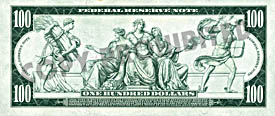
Five allegorical figures from mythology depicted on the series 1914 $100. note.
The God Mercury is on the right wearing his winged helmet and sandals.
The
Romans called this God “Hermes.” “Mercury” was the
name used by the Greeks. He was the messenger of the Gods and also the
guide to the Underworld. His father was Zeus, King of the Gods, and his
mother was a mountain nymph.
Mercury is always seen wearing sandals with wings. These allowed him to
fly and to move with great speed. His helmet, also containing wings, made
him invisible and contributed to his stealthness.
He carried a caduceus or staff, which was his symbol as divine messenger.
It was originally made of a willow wand entwined with ribbons. Mythology
states that he intervened between two fighting snakes, and they then twined
themselves together in peace on his staff. This caduceus has evolved into
the modern symbol of medicine and healing.

Mercury-—The Messenger of the Gods
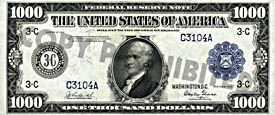
Series
1918 - One Thousand Dollar Note
Alexander Hamilton illustrated on the one thousand
dollar bill
The $500, $1,000, $5,000, and $10,000 denominations were first issued in 1918. Although examples of the $5,000 and $10,000 notes exist in U. S. Government collections, there are no known copies that exist in the public domain and thus they are unavailable to collectors.

(1757-1804) founding father, first Secretary of the Treasury, advocate of strong national government, member of the Continental Congress and Constitutional Convention, co-author of the Federalist Papers, proposed Bank of the U. S., helped create Federalist Party, died in a duel with rival Aaron Burr.
 The
front side of this rare postcard written on the Titanic on April 10, 1912.
It was mailed at Queenstown, Ireland.
The
front side of this rare postcard written on the Titanic on April 10, 1912.
It was mailed at Queenstown, Ireland.“Not even God himself could sink this ship”—Comment of a White Star employee about the Titanic
RIGHT:
Oscar Scott Woody was one of five Postmasters working on the Titanic with
four other assistants to safeguard the mail. Sea mail was taken very seriously
and was an important souce of revenue for steamship companies.
The night of April 14, 1912, when they were
celebrating O.S. Woody’s 44th birthday, the mail clerks knew something
was wrong when the Titanic collided with an iceberg. They moved as many
of the 200 registered mail bags to the top deck as possible to keep the
mail dry, but eventually found themselves in the cold water, none of them
able to secure a place in a lifeboat.
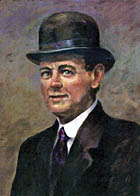
Sea post clerk Oscar Scott Woody
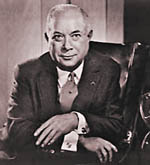
David Sarnoff-On the evening of April 14, 1912, Sarnoff was working at the Marconi station atop Wanamaker’s department store in New York City and was the first person to pick up the message relayed from ships at sea: “S.S. Titanic ran into iceberg, sinking fast.”

The stamp issued for use on the world’s first airmail service was put on sale May 13, 1918. It was a 24-cent stamp picturing a Curtiss Jenny mail biplane and was printed in two colors.

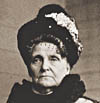
ABOVE LEFT: William Robey, discoverer of the JENNY. Robey was aware of the possibility of the new airmail stamp being accidentally printed with the center inverted. He told his wife that he wanted to go to the post office before work, because “I have a strange feeling there’s going to be a mistake.” The clerk reached down and pulled out one sheet of one hundred stamps with the blue plane printed upside down. Robey’s “heart stood still.” …“A thrill that comes once in a lifetime.” “Give me another one like the one I just bought.” Robey left the post office in great haste when the clerk slammed the window shut.

Col. Edward Howland Robinson Green, Mrs. Green’s son, who inherited half of her possessions. After his mother’s death, Ned started spending his inheritance and shortly thereafter began collecting stamps. Eugene Klein sold the stamps to Col. Green for $20,000.
Photos from the book “The Witch of Wall Street” by Boyden Sparkes and Samuel Taylor Moore